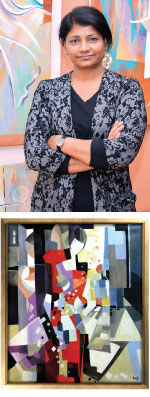Ella Prakash’s studio in Adliya bursts with colour. Her paintings are kaleidoscopically rich in strokes and texture; their nature, however, is far from bright. She talks to Georgie Bradley about why she adds colour to dark subjects.

After 50 years of living in Bahrain, Ella Prakash is a mainstay. Despite the modest art scene on the island, she has managed to carve a niche for herself over the last 10 years and is now showcasing her work across the globe.
Breaking the Mould
It was always a passion of Ella’s to paint, something she really honed into her late teens, and was part of the Bahrain Arts Society. But when she got married her passion came to a standstill. “I stopped everything. Art wasn’t even my hobby anymore,” says Ella. Instead, her priorities were housebound, leaving little room for art. “In India, it is considered a woman’s duty to take care of the house, and the in-laws.”
And then in 2002 it all came together. “When my youngest was four, I thought, ‘I can’t do this. I have to come out of this situation and paint again’ and I started teaching art to kids and I also painted a portrait of the King and realised I still had it in me to paint.”
With a renewed spirit for art, Ella opened her first gallery in Hoora until 2011 and is now based in Adliya.
Women Suffering
One of her main preoccupations is women – specifically women who suffer. Her art focuses on the female condition and the pains, mainly silent, that women have bottled up. “I decided to paint women in sorrowful situations because it was something that came the most naturally to me. I couldn’t force anything else; nothing was coming to me.”
Although you’ll find endearingly beautiful paintings of Bahrain – the souq, orange-blazed sunsets and dhows, her studio is lined with paintings of abstractly expressed female suffering. Her work plays with rhythms, lines, angles and sharp corners – although the contours of a woman do stand out. “The intention is to express women suffering at the helm of a partner or a domestic situation. There is a lot of silence in suffering, especially with women. But I wanted to express it in a beautiful way because women have been put down a lot. They are unsung heroes.”
Happy Colours
“My paintings are not negative. The colours are bright and give an element of optimism to women,” explains Ella. “I only paint white faces. To me, it’s purity.” But doesn’t that spark a potentially racial argument? “I don’t treat the colour as a skin tone, but more of a clean blank canvas, so that it can apply to women of all ethnicities.”
She motions to one of her paintings and describes the delicate, forlorn woman looking out of a window as a representation of looking ahead, and seeing a horizon of hope. Indeed, much of the theme of women suffering stems from her own frustrated ambitions as an artist.
Though now, through her 10-year artistic odyssey, Ella is on top form having showcased her work in Miami alongside Nina Torres, in a Brick Lane Gallery, in London’s east end and is currently having her work Never Let You Go and Walk With You (curated by Barry Martin) featured at Debut Contemporary’s ‘Human Suffering at Times of Crisis Part 2’ private viewing in Notting Hill, west London, which started on December 3. The exhibition is to raise awareness on the fatal Duchenne muscular dystrophy disease and 20 per cent of the artwork sold will go towards the Harrison’s Fund charity.
“Never Let You Go and Walk With You is about how time decides every aspect, where relationships are held at face value, and the only relation that remains eternal and pure is the bond between a mother and child. The painting depicts a tragedy where a mother doesn’t lose faith in her relationship with her child, keeping that bond of mental strength for eternity.”
Ella is launching a solo show in March 2015 at Debut Contemporary in London – and in Italy in September 2015. In 2016 she is set to do a solo show at the New Delhi India Habitat Centre.


































